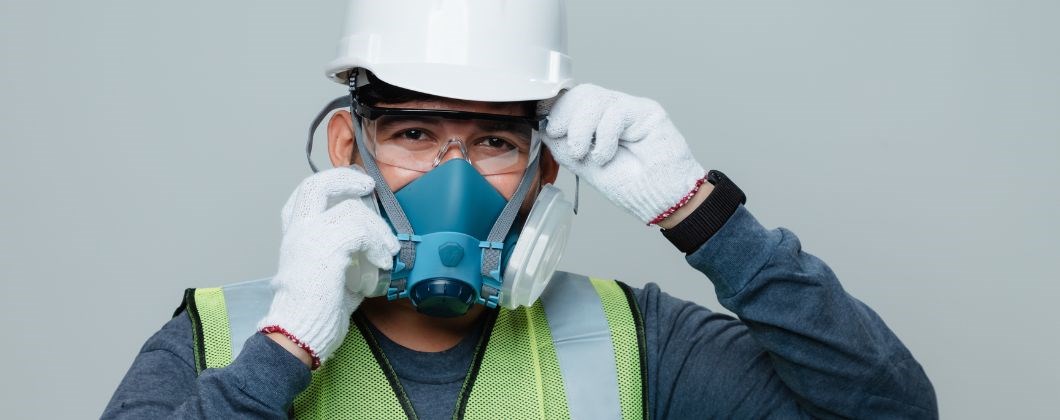Choosing the Right Respiratory Protective Equipment

Work activities in industries such as construction and manufacturing can result in harmful substances contaminating the air from dust, mist, gases and fumes. When used properly, respiratory protective equipment (RPE) helps protect against such hazards.
However, some RPE types may not provide satisfactory protection in every situation. In fact, recent research by the Health and Safety Executive (HSE) found that respirators and masks held in place by ear loops do not provide adequate protection for the vast majority of employees.
Protect your health by making sure you know which RPE is best for the task at hand.
Importance of RPE
With correct use, RPE is an important tool for health and safety protection. Inhalation of hazardous substances can have many adverse health effects and, in some cases, even result in fatalities. In fact, 12,000 deaths each year are estimated to be linked to work-related respiratory diseases, primarily due to asbestos, according to the HSE. Therefore, it’s vital you know what to look for when selecting RPE.
What to Consider:
To ensure you’re protected, select RPE that is:
- Adequate—RPE should provide adequate protection against any workplace hazards, reducing exposure levels sufficiently so there is no harm to health.
- Suitable—RPE should be suited to the task, well-fitted and allow for free movement.
RPE Types
There are two main types of RPE:
- Respirator—Also known as filtering devices, respirators remove contaminants from the air using filters. Respirators can be powered (with a motor to move air) or unpowered (in which the wearer’s breath moves air through the filter).
- Breathing apparatus (BA)—This RPE type provides an independent supply of air to the wearer. As such, it’s mainly used if oxygen levels are low.
Respirators and BAs can be:
- Tight-fitting face pieces—Also known as masks, these can be powered, non-powered or BAs. Masks must have a tight seal with the wearer’s face and be fit tested prior to use.
- Loose-fitting face pieces—Available only as powered respirators or BAs, this RPE type relies on enough clean air being provided to the wearer to prevent contaminants from leaking in. Examples are hoods, helmets, visors, blouses and suits.
RPE Selection
When selecting RPE, check first if it’s necessary for the task you’re undertaking. Employers are legally required to carry out risk assessments under the Control of Substances Hazardous to Health (COSHH) regulations. As such, RPE should only be used once all other reasonably practicable measures have been taken to prevent or control exposure. Check with your employer to determine what control measures are already in place.
Should the risk assessment still recommend RPE, the type you choose will depend on the hazard you’re working with. Depending on the task, you may be exposed to the following:
- Hazardous particles—Particles (either solid or liquid) such as asbestos dust, stone dust, fungal spores, paints and pesticides will likely require RPE use.
- Hazardous vapours and gases—RPE will likely be needed for exposure to solvent or mercury vapour, chlorine and carbon monoxide engine exhaust gases.
Note that some hazards may be present in multiple forms simultaneously (ie both particles and gases), such as when spray painting. Respirators have two basic types of filters, depending on the hazard; one for gas/vapour and one for particles. Filters can’t be used interchangeably; they are specific to each hazard. However, you may be able to use different filters in combination when hazards are present in multiple forms. Therefore, it’s crucial to know which filter or filters are necessary for a given task, as informed by your employer.
Unlike respirators, most BAs do not utlise filters because they rely on a dedicated supply of oxygen.
Additionally, you’ll also need to assess the RPE’s Assigned Protection Factor (APF). The APF indicates the amount of protection RPE gives. The manufacturer ratings are from 4 to 2000, and the APF must be high enough to protect the wearer. You can usually find an RPE’s APF within the Safety Data Sheets or on the HSE’s Workplace Exposure Limits (WEL) webpage.
In addition, check the fit of your chosen RPE. RPE is available in different sizes to allow for facial differences, so choose one that fits you well. Further, make sure it’s compatible with any other personal protective equipment you’re using. Your employer will be able to help you assess whether your RPE fits adequately.
Conclusion
RPE is vital in protecting you from harm in the workplace, and in some cases, it could be a lifesaver. Choose RPE that fits you well and offers the correct protection. Additionally, use RPE only once you’ve been trained by your employer in its proper use. If you have any health and safety concerns, speak to your supervisor without delay.
Our manufacturing insurance team and in-house risk management team have a wealth of knowledge, experience and free resources they can offer you to help reduce workplace accidents and potentially reduce your manufacturing insurance premiums. Get in touch today.
